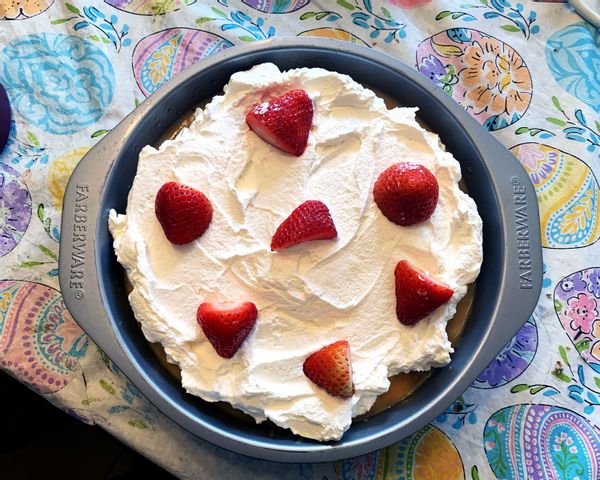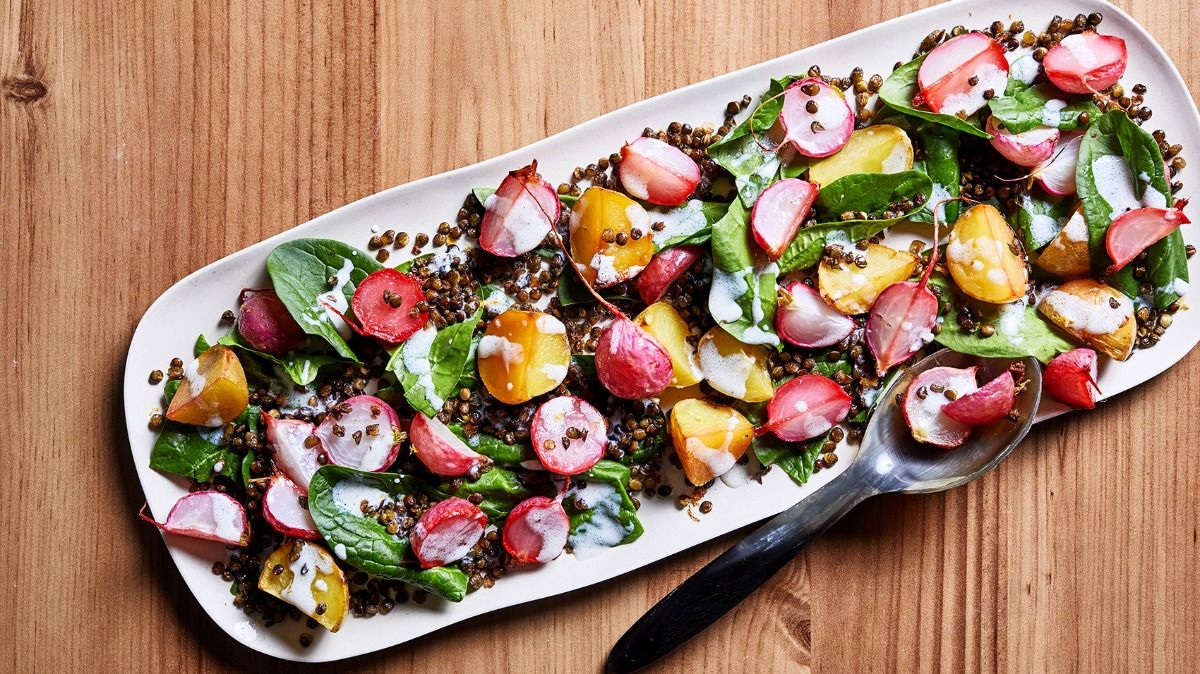Ubiquitous among biscuits, fried chicken, pancakes and salad dressings, buttermilk is a seemingly commonplace ingredient that still manages to mystify many. But what was initially an oft-discarded byproduct of butter-making has become a cherished ingredient in and of itself, lending heft and flavor to baked goods, tenderizing meats and bringing a viscosity and richness to many sauces and dressings.
What exactly is buttermilk, though?
Oddly enough, most Google searches for buttermilk ask the same thing: "What can I substitute for buttermilk?" Clearly, what's assumed to be a staple isn't often found in most home kitchens. Perhaps that's because this tangy, thick and slightly sour fermented dairy product is primarily known for how it elevates other foods. After all, it's rare in 2021 to hear anyone boast about drinking copious glasses of buttermilk on its own. But in attempting to demystify buttermilk, perhaps that's just what we should start doing — allow this unique ingredient to shine on its very own once and for all.
The notion of buttermilk may conjure up romanticized images of people churning butter in the olden days, but it is — like 99% of everything currently on grocery shelves — now a major industry in and of itself. Present-day buttermilk is thick, almost like a thin yogurt in texture but with exponentially less fat than regular milk. Its tart flavor comes from lactic acid in the presence of active cultures, which are added to pasteurized, fresh milk. Some also include thickening agents, salt or other additives.
Of course, this differs exponentially from the origins of buttermilk, which was originally a mere byproduct that resulted during butter churning and production. Due to the way that butter was produced prior to refrigeration, the thin liquid would pool at the bottom of the churning mechanisms and naturally create active cultures, which would preserve it longer than fresh milk, cream, or butter, according to Cooks Illustrated. Furthermore, The Spruce Eats notes that "fermentation converts the milk sugars into lactic acid," which explains the tart, tangy flavor present in buttermilk.
Many would merely discard this runoff, but others began to utilize it, not letting any aspect of the process go to waste. We can now differentiate between the two as cultured vs. churned buttermilk, but both are fermented products that boast probiotics and other health benefits, similar to kefir, kombucha and sauerkraut, according to Southern Living. It's also very helpful for digestion and acid reflux issues, per The Spruce Eats.
How do I use buttermilk?
Thank goodness for our ancestors, who didn't simply throw out their buttermilk. Nowadays, it's one of the most multi-faceted and useful ingredients imaginable. In addition to its widely known properties within salad dressings, fried chicken, breakfast foods and baked goods, it also adds tartness to smoothies and mashed potatoes, can act as an alternative to mayonnaise in potato salads or coleslaws and adds tang to gravies and sauces.
It's a delicious — and surprising — inclusion in many creamy soups. It's a natural tenderizer for meats and poultry. If you're not a fried chicken person, try a roasted chicken that's been marinating in buttermilk for a few hours before being dried off and cooked in the oven. This is a Samin Nosrat staple that has gone "viral" again and again — and for good reason.
Buttermilk is also a classic throughout the southern U.S. It's widely in many regional pies and specialty baked goods. It pairs beautifully with citrus — primarily lemon — and when it comes to baked goods, it adds both flavor and structural integrity. It works in conjunction with leavening agents, and its acidity also helps to create air bubbles, resulting in tender, flaky, moist baked goods.
One important buttermilk note
One important buttermilk note: Always shake before using! The Spruce Eats notes that 1 gallon of heavy cream yields about 1/2 pint of buttermilk, and that goes to show you just how much butter churning was needed to result in a usable amount of buttermilk. However, we don't have to worry about churning enough butter to have a requisite quantity of the cherished dairy product — and this convenience and privilege allow us to use buttermilk all year round.
***

Recipe: Blood Orange Tart with Whipped Buttermilk and Candied Citrus
For the curd:
- 5 eggs
- 4-5 blood oranges, juiced
- 1-2 lemons, juiced
- Blood orange zest
- Lemon zest
- 1 1/4 cups sugar
- Pinch kosher salt
- 1 stick butter
- 2 Tbsp. honey (optional)
- Mix all ingredients except butter incredibly well. [Be sure to whisk the mixture until fully homogeneous before moving to the stove, or else there may be (appealing) clumps of cooked or scrambled egg throughout. If that does happen — no worries — you can just strain it out, but the finished curd may not be as thick as intended.]
- Cook over low heat for about 10 minutes, stirring constantly until mixture is nappe and super fragrant. Add pats of butter — one at a time — until melted and well-stirred. Pour into heat-proof bowl, cover with plastic wrap and press against surface of curd. Cool completely before refrigerating.
For the crust:
- 2 cups crushed amaretti cookies, crushed gingersnaps, crushed graham crackers, etc.
- 5-6 tablespoons unsalted butter, melted
- Pinch sugar
- Granulated or brown sugar (optional)
- Preheat oven to 350.
- Grease a 9-inch pie pan or springform pan.
- Blend all ingredients until uniform. Press into bottom and up sides of pan.
- Cook for 8-10 minutes. Cool, and refrigerate until ready to serve.
For the whipped topping:
- 1 cup heavy cream
- 3/4 cup buttermilk
- 1 tsp. extract of choice (optional)
- Combine heavy cream and buttermilk, and whip until thick and airy — just before stiff peaks.
For the topping:
Candied citrus peels, homemade or store-bought (As in the photo, you can substitute strawberries if you don't have any on hand.)
Assembly:
- Remove pie pan from refrigerator. Pour cooled curd into shell, and spread evenly and consistently. Top with whipped buttermilk-cream, and garnish with candied citrus peels. Serves 8-10.
***

Recipe: Buttermilk-Vanilla Granita with Trio of Syrups (Cherry, Rhubarb, and Oleo Saccharum)
For the granita:
- 1 cup cultured or freshly churned buttermilk (if you're lucky enough to be able to get your hands on some)
- 1 Tbsp. granulated sugar
- 1 tsp. vanilla extract
- Unsalted, shelled pistachios, crushed or pulverized
- In a shallow baking dish, combine all ingredients but pistachios until homogenous and well-mixed. Freeze until solid.
- When ready to serve, use tines of large fork to scrape surface of frozen buttermilk mixture, resulting in a snow cone-esque frozen treat.
- Transfer to a small bowl. Add desired syrups, and top with crushed pistachios.
NOTE: While refreshing and ridiculously simple, granita melts quickly, so be sure to serve it ASAP.
Cherry-Almond Syrup:
- 1.5 cups fresh or frozen pitted cherries
- 1/3 cup granulated sugar
- 1 tsp. almond extract
- In a small pot over low heat, simmer cherries and sugar until mushy. Lightly crush with a potato masher, spoon or spatula until cherries release their juices and mixture. Add extract. Strain, discard solids and let syrup cool.
Rhubarb-Lemon Syrup:
- 1.5 cups rhubarb, chopped
- 1/3 cup granulated sugar
- 1 lemon, zested
- In a small pot over low heat, simmer rhubarb, sugar and zest until mushy. Lightly crush with a potato masher, spoon or spatula. Strain, discard solids and let syrup cool.
Oleo Saccharum:
- 2-3 oranges (blood orange, Cara Cara, mineola, etc.)
- 1 lemon
- 1/4 cup granulated sugar
- Using a vegetable peeler, peel oranges into widest strips possible. Combine with sugar in a small bowl and let sit, covered, for 4 hours or so. Strain, lightly press and discard peels.
***
Recipe: Herbed Buttermilk-Poppy Dressing
- 1 cup buttermilk
- 3/4 cup yogurt or mayonnaise
- 2-3 cloves garlic, grated
- 3-4 leaves sage, chopped
- 1 scallion, chopped
- 2 Tbsp. grated Parm
- 1 Tbsp. white wine vin or citrus juice
- 1-2 Tbsp. parsley, chopped
- Kosher salt
- Freshly cracked black pepper
- 1 tsp. garlic powder
- 1 tsp. onion powder
- 1-2 tbsp. poppy seeds
- Combine all ingredients. Chill until ready to serve. Pair with radishes, celery, carrots, buttermilk-battered chicken, etc.
***
A slight twist on the "standard breading procedure," this method swaps an egg/water or egg/milk mixture for half egg and half buttermilk, which helps to tenderize and flavor the chicken. If a whole roasted chicken bathed in buttermilk or classic buttermilk fried chicken is intimidating, try out this cutlet method for a simple, delicious alternative.
Recipe: Buttermilk-Battered Chicken Cutlets
- 1 lb chicken breasts
- 1 cup AP flour
- Kosher salt
- Freshly cracked black pepper
- Garlic powder
- Onion powder
- 2 eggs
- 2-3 Tbsp. buttermilk
- 1 cup breadcrumbs
- 1/2 cup grated Parm or pecorino
- Extra-virgin olive oil
- In one shallow bowl, mix flour with salt, pepper, garlic and onion powder. In another shallow bowl, mix eggs, buttermilk, salt and pepper. In a third bowl, combine bread crumbs, cheese, onion powder, garlic powder, salt and pepper. Season chicken with salt and pepper, and then dredge in flour. Move to egg-buttermilk mixture, shaking to discard excess and then into breadcrumb-cheese mixture. Repeat with rest of chicken.
- Warm olive oil in a large, heavy-bottomed pan over medium heat. Add chicken — being careful not to crowd —and cook, flipping, until deeply browned and crisp.
- Move chicken to a cooling rack fitted inside a baking sheet. Season lightly with flaky salt. Serve with herbed buttermilk-poppy dressing.



Shares